ICT in enterprises and the environment
Data extracted in June 2023
Planned article update: June 2026
Highlights
In 2022, 58.5 % of EU enterprises reported that they consider the environmental impact when choosing ICT services or ICT equipment.
In 2022, 66 % of EU enterprises applied some measures to optimise the amount of paper used for printing and copying.
Enterprises considering the environmental impact of ICT services or ICT equipment, when selecting them, 2022
For decades, the adoption of digital technologies by enterprises has not only had an impact on their performance but also on environmental aspects. As the EU has a plan to become the first climate-neutral continent, it is important that enterprises take steps to reduce the environmental impact of their digital transformation.
The article presents recent statistical data on some environmentally-friendly procedures that enterprises are undertaking to reduce their environmental impact when selecting or using ICT services or equipment or disposing of unused ICT equipment.
Full article
Considering the environmental impact when buying ICT equipment
When purchasing ICT services or equipment, enterprises are taking into account the characteristics which have an impact on the environment. Examples are:
- energy consumption,
- whether they are made from easily recyclable or recycled materials,
- whether they were produced entirely with clean energy,
- minimal recyclable packaging,
- easily repairable and highly sustainable equipment, enabling users to download free firmware updates to fix problems with batteries rather than replacing them if they malfunction due to firmware problems.
As presented in Figure 1, in 2022, 58.5 % of EU enterprises with 10 or more employees and self-employed persons reported that they consider the environmental impact of ICT services or ICT equipment when selecting them. Large enterprises considered this impact to a greater extent compared with medium and small enterprises: 70.2 % for large enterprises, 63 % for medium enterprises and 57.3 % for small enterprises.
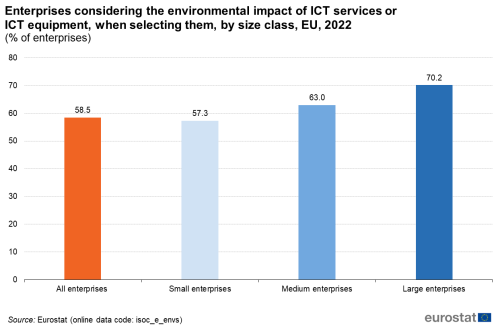
(% of enterprises)
Source: Eurostat (isoc_e_envs)
Concerning the economic activity in which enterprises were operating, there were no substantial differences in the shares between enterprises that consider the environmental impact of ICT services or ICT equipment when selecting digital solutions, in the different economic sectors (Figure 2). The share ranged between 65.6 % and 48.1 %. The highest share was recorded in the information and communication sector, in which 65.6 % of enterprises considered the environmental impact of ICT services or ICT equipment when purchasing them, followed by electricity, gas, steam and air conditioning supply activities (64.4 %). The lowest share of enterprises was recorded in accommodation and food service activities (48.1 %), which was the only activity where the share of enterprises that considered the environmental impact of ICT services or ICT equipment when selecting them was below 50 %.

(% of enterprises)
Source: Eurostat (isoc_e_envn2)
The comparison of enterprises considering environmental impacts of ICT services or ICT equipment when selecting them between EU countries (Figure 3) shows that the share ranged between 75.1 % and 14.3 % and that eleven countries were above the EU average (58.5 %). In 2022, the country with the highest share of enterprises taking into account the environmental impact of ICT services or ICT equipment when selecting them was Portugal (75.1 %), followed by Italy (74.9 %), Cyprus (71.1 %) and Romania (70.8 %). The lowest shares were recorded in Greece (14.3 %), and Croatia (26.5 %).

(% of enterprises)
Source: Eurostat (isoc_e_envs)
Measures used for reducing the environmental footprint of ICT equipment
When using ICT equipment, enterprises can apply different measures to reduce their environmental footprint. In 2022, 66 % of enterprises in the EU, with 10 or more employees and self-employed persons, reported that they applied some measures optimising the amount of paper used for printing and copying, and 44.1 % of EU enterprises applied measures optimising energy consumption of the ICT equipment they use. Large enterprises more often applied measures that optimise their environmental footprint compared with medium and small enterprises. In 2022, 78.7 % of EU large enterprises applied measures optimising the amount of paper used for printing or copying, followed by medium enterprises (71.4 %) and small enterprises (64.7 %). Around 62.1 % of large EU enterprises reported that they applied some measures to limit or optimise the energy consumption of their ICT equipment, followed by medium enterprises (50.8 %) and small enterprises (42.3 %), see Figure 4.
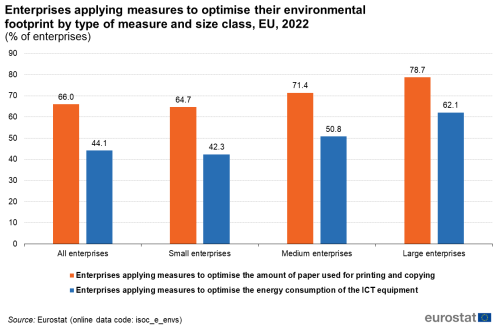
(% of enterprises)
Source: Eurostat (isoc_e_envs)
When looking at enterprises applying measures to optimise their environmental footprint according to the economic activity of the enterprise, Figure 5 shows that in 2022 more than half of EU enterprises in all covered economic activities applied measures to optimise the amount of paper used for printing and copying. The highest share of enterprises was recorded in the professional, scientific and technical service activities (73.1 %), followed by the information and communication sector (71.7 %) and the electricity, gas, steam and air conditioning supply sector (70.7 %); the lowest shares were in accommodation and food service activities (59.0 %), manufacturing (63.9 %) and construction (65.2 %).
Compared with enterprises that apply measures optimising their environmental footprint by limiting the amount of paper used for printing or copying, the share of enterprises limiting or optimising energy consumption of their ICT equipment was lower in all economic activities. The share was higher than 50 % in two sectors, namely the information and communication sector (52.9 %) and the electricity, gas, steam and air conditioning supply sector (52.5 %). In other economic activities the share ranged between 47.8 % (professional, scientific and technical activities) and 39.3 % (accommodation and food service activities), see Figure 5.

(% of enterprises)
Source: Eurostat (isoc_e_envn2)
As presented in Figure 6, 68.4 % of EU enterprises reported in 2022 that they applied some measures to optimise the amount of paper used or the energy consumption of their ICT equipment. The share varies significantly across the EU countries and ranged between 79.5 % and 25.2 %. The highest share of enterprises applying such measures was recorded in Austria (79.5 %), followed by the Netherlands and Finland (both 77.0 %), while the lowest shares were recorded in Hungary (25.2 %) and Ireland (46.5 %).
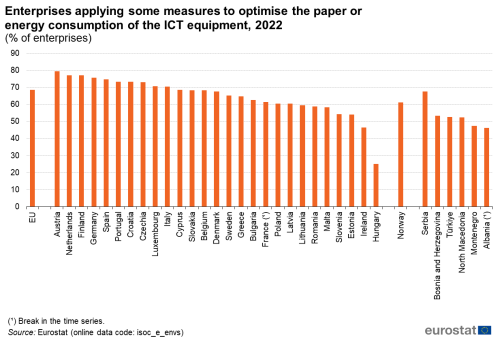
(% of enterprises)
Source: Eurostat (isoc_e_envs)
Disposing of unused ICT equipment
Enterprises have different ways of disposing of unused ICT equipment (e.g. computers, monitors, mobile phones), some of them can help to create more circular economy. It can be disposed of via electronic waste collection/recycling (by the enterprise itself or a retailer) or can be kept in the enterprise (e.g. for using as spare parts or to prevent sensitive information being disclosed) or can be sold, returned to the leasing enterprise, or donated, with the goal of being re-used within another organisation (second life-cycle), when it is no longer used. Enterprises can use one, two or all three ways of disposing of unused ICT equipment.
As presented in Figure 7:
- 77.4 % of EU enterprises with 10 or more employees and self-employed persons reported that they dispose of ICT equipment from the enterprise via electronic waste collection/recycling,
- 49.5 % of EU enterprises keep ICT equipment in the enterprise and
- 28.3 % of enterprises sell, return to a leasing enterprise, or donate their ICT equipment when it is no longer used.
Concerning the size class of an enterprise and the way unused ICT equipment is disposed of, the biggest difference between large and small enterprises (26 percentage points) was recorded for those enterprises that sell, return to a leasing enterprise, or donate ICT equipment when no longer used (Figure 7).
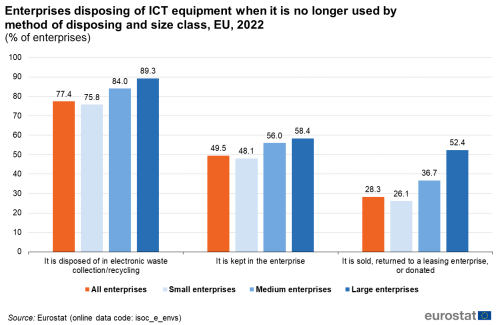
(% of enterprises)
Source: Eurostat (isoc_e_envs)
The share of enterprises reporting in 2022 that they disposed of their ICT equipment via electronic waste collection/recycling when it was no longer used did not differ significantly across the different economic activities. The highest share was recorded among enterprises operating in water supply; sewerage, waste management and remediation activities (86.0 %), while the lowest was in accommodation and food service activities (71.1 %). A bigger difference was recorded for enterprises that keep their unused ICT equipment in the enterprise. The highest share was recorded in information and communication (62.9 %), while the lowest was in accommodation and food service activities (38.9 %).
Figure 8 presents the share of enterprises that sell, return to a leasing enterprise, or donate their ICT equipment when it is no longer used in the different economic activities. The highest share of enterprises that sell, return to a leasing enterprise, or donate their ICT equipment when it is no longer used was reported in the information and communication sector (47.7 %), followed by electricity, gas, steam and air conditioning supply activities (44.7 %) and professional, scientific and technical activities (39.8 %). The lowest shares of those enterprises were recorded in accommodation and food service activities (24.2 %), construction (24.6 %) and water supply; sewerage, waste management and remediation activities (24.7 %).

(% of enterprises)
Source: Eurostat (isoc_e_envn2)
A closer look at the cross-country comparison of enterprises that reported that they sell, return to a leasing enterprise, or donate their ICT equipment when it is no longer used, shows that the share ranged between 41.6 % and 14.2 % (Figure 9). The highest share of enterprises that reported that they sell, return to a leasing enterprise, or donate their ICT equipment when it is no longer used was in Finland (41.6 %), followed by Germany (35.8 %), Portugal (35.5 %), Slovenia (34.7 %) and Czechia (34.5 %), while the lowest shares were recorded in Ireland (14.2 %), Greece (18.6 %) and Spain (19.7 %).
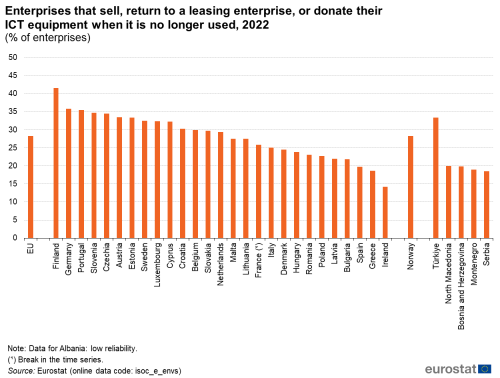
(% of enterprises)
Source: Eurostat (isoc_e_envs)
Source data for tables and graphs
Data sources
Source: Data presented in this article are based on the results of the 2022 Community survey on 'ICT usage and e-commerce in enterprises'. Statistics were obtained from surveys in enterprises conducted by National Statistical Authorities in the first months of 2022.
Sample: In 2022, some 150 400 enterprises, with 10 or more employees or self-employed persons, out of 1.47 million in the EU were surveyed. Out of these 1.47 million enterprises, approximately 83 % were small enterprises (with 10-49 employees or self-employed persons), 14 % medium (50-249 employees) and 3 % large enterprises (250 or more employees).
Main concepts: The observation statistical unit is the enterprise, as defined in the Regulation (EEC) No 696/1993 of 15 March 1993. The survey covered enterprises with at least 10 employees or self-employed persons. Economic activities correspond to the classification NACE Revision 2. The sectors covered are manufacturing, electricity, gas and steam, water supply, construction, wholesale and retail trades, repair of motor vehicles and motorcycles, transportation and storage, accommodation and food service activities, information and communication, real estate, professional, scientific and technical activities, administrative and support activities and repair of computers and communication equipment.
Context
Digital transformation can have a positive impact on the environment and on environmental sustainability by applying environmentally friendly procedures.
Digital transformation is high on the European policy agenda, with making Europe fit for the digital age and empowering its citizens and businesses with a new generation of technologies being one of the main political priorities of the European Commission for the coming years. In 2021, the Digital Compass for the EU's Digital Decade (COM(2021)118 final), set the EU’s digital targets for 2030, evolving around four cardinal points: skills, digital transformation of businesses, secure and sustainable digital infrastructures, and digitalisation of public services.
The relevant statistics are related to the Commission priority “A European Green Deal”, which is the roadmap for making the EU's economy sustainable. The policy priority is for the moment to focus on three dimensions of the positive impact of ICT in the environment (green ICT, ICT for sustainability): enterprises' environmentally friendly procedures, home office and virtual meetings.
Direct access to
See also
- Digital economy and society statistics - enterprises
- Use of artificial intelligence in enterprises
- Use of Internet of Things in enterprises
- Cloud computing - statistics on the use by enterprises
- ICT specialists - statistics on hard-to-fill vacancies in enterprises
- E-commerce statistics
- E-business integration
- ICT security in enterprises
- Social media - statistics on the use by enterprises
- Impact of COVID-19 on the use of ICT in enterprises
- Impact of COVID-19 on e-sales of enterprises
Main tables
Database
- Digital economy and society (isoc)
- ICT usage in enterprises (isoc_e)
- ICT and environment by NACE Rev.2 activity (isoc_e_envn2)
- ICT and environment by size class of enterprise (isoc_e_envs)
- ICT usage in enterprises (isoc_e)
Dedicated section
Methodology
- ICT usage and e-commerce in enterprises (ESMS metadata file — isoc_e_esms)
Legislation
- Regulation (EU) 2019/2152 of the European Parliament and of the Council of 27 November 2019 on European business statistics
- Regulation (EC) No 808/2004 of the European Parliament and of the Council of 21 April 2004 concerning Community statistics on the information society
- Regulation (EC) No 960/2008 of 30 September 2008 implementing Regulation (EC) No 808/2004 concerning Community statistics on the information society
- Regulation (EC) No 1023/2009 of 29 October 2009 implementing Regulation (EC) No 808/2004 concerning Community statistics on the information society
- Regulation (EU) No 821/2010 of 17 September 2010 implementing Regulation (EC) No 808/2004 concerning Community statistics on the information society
- Regulation (EU) No 937/2011 of 21 September 2011 implementing Regulation (EC) No 808/2004 concerning Community statistics on the information society
- Regulation (EU) No 1083/2012 of 19 November 2012 implementing Regulation (EC) No 808/2004 concerning Community statistics on the information society
- Regulation (EU) No 859/2013 of 5 September 2013 implementing Regulation (EC) No 808/2004 concerning Community statistics on the information society
- Regulation (EU) No 1196/2014 of 30 October 2014 implementing Regulation (EC) No 808/2004 concerning Community statistics on the information society
- Regulation (EU) 2015/2003 of 10 November 2015 implementing Regulation (EC) No 808/2004 concerning Community statistics on the information society
- Regulation (EU) 2016/2015 of 17 November 2016 implementing Regulation (EC) No 808/2004 concerning Community statistics on the information society
- Regulation (EU) 2017/1515 of 31 August 2017 implementing Regulation (EC) No 808/2004 concerning Community statistics on the information society
- Regulation (EU) 2018/1798 of 21 November 2018 implementing Regulation (EC) No 808/2004 of the European Parliament and of the Council concerning Community statistics on the information society for the reference year 2019
- Regulation (EU) 2019/1910 of 7 November 2019 implementing Regulation (EC) No 808/2004 of the European Parliament and of the Council concerning Community statistics on the information society for reference year 2020
- Regulation (EU) 2020/1030 of 15 July 2020 laying down the technical specifications of data requirements for the topic ‘ICT usage and e-commerce’ for the reference year 2021, pursuant to Regulation (EU) 2019/2152 of the European Parliament and of the Council
- Regulation (EU) 2021/1190 of 15 July 2021 laying down the technical specifications of data requirements for the topic ‘ICT usage and e-commerce’ for the reference year 2022 pursuant to Regulation (EU) 2019/2152 of the European Parliament and of the Council